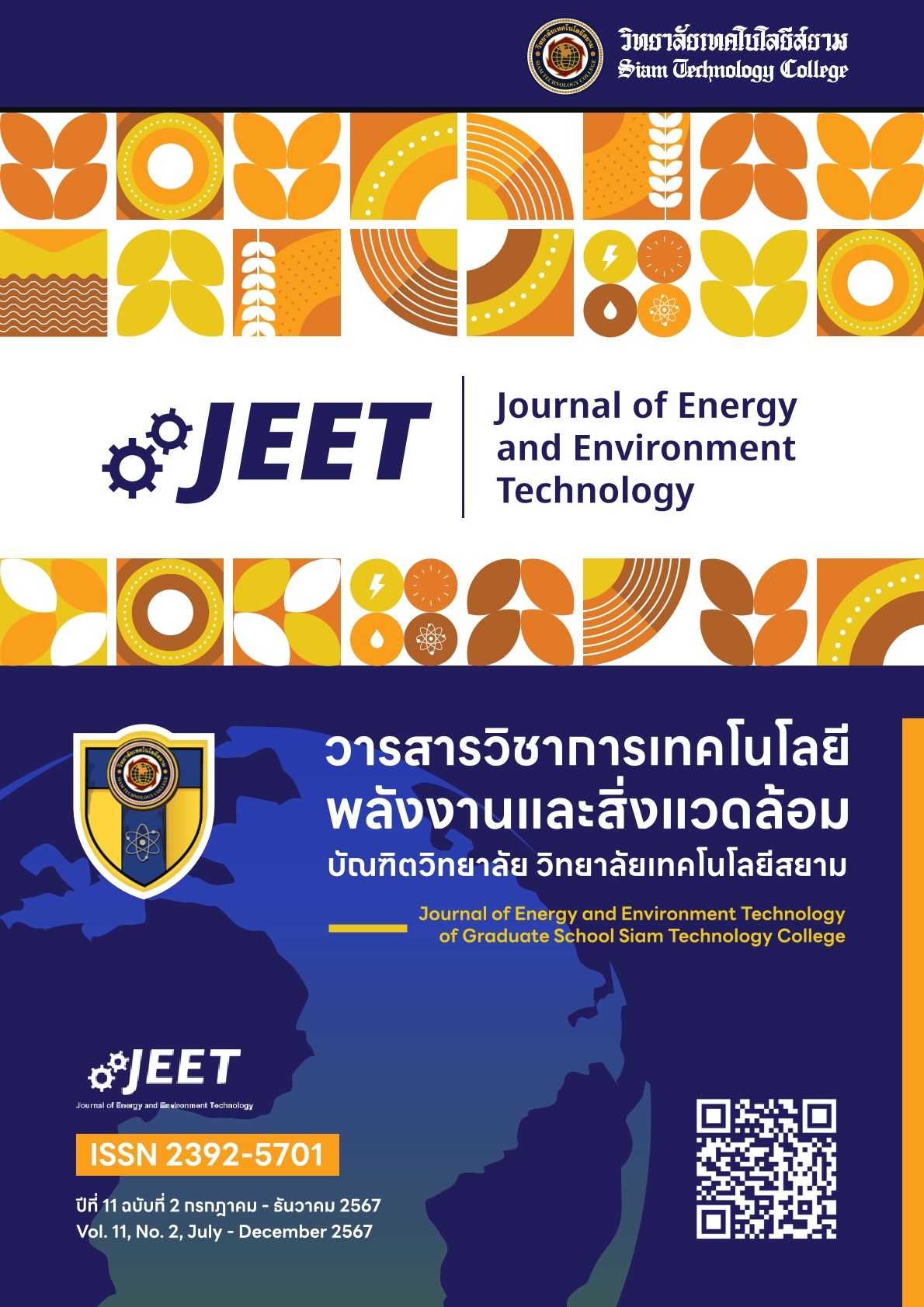AN ASSESSMENT AND FORECASTING OF CARBON DIOXIDE (CO2) EMISSIONS FROM THE TRANSPORTATION SECTOR USING REGRESSION ANALYSIS AND ARTIFICIAL NEURAL NETWORK METHODS
Main Article Content
Abstract
Economic growth and population density have led to a continuous increase in energy consumption, resulting in carbon dioxide (CO2) emissions becoming a critical issue that all countries need to manage effectively and appropriately. CO2 is a major contributor to climate change, air pollution, and adverse effects on human livelihoods, particularly in the transportation sector, which shows a significant upward trend. Thus, understanding the future trends and patterns of CO2 emissions can assist policymakers in developing measures and initiatives that are responsive to these changes. This research aims to forecast CO2 emissions from the transportation sector using regression analysis and neural network models. The study employs data on energy consumption, the number of registered vehicles, population size, gross domestic product (GDP), and regional economic confidence indices from 2007 to 2023. The results show that the neural network model provides more accurate and efficient CO2 emission forecasts than the regression model, as indicated by the root mean square error. Additionally, a five-year forward forecast, assuming that energy consumption, the number of registered vehicles, and GDP increase at a rate of 1% per month, predicts a continuous rise in CO2 emissions. When comparing the forecast results of the two models at any given time point, it is observed that the regression model consistently yields higher predicted values than the neural network model, with an average difference of 6,787,756 tons. As the forecast horizon extends, the disparity between the predictions from the two models becomes progressively larger. With the forecasting capabilities of the neural network model, policymakers and regulatory agencies can formulate more effective and sustainable environmental management policies. It can be utilized to continuously monitor CO2 emission trends and evaluate the effectiveness of CO2 emission reduction strategies.
Article Details

This work is licensed under a Creative Commons Attribution-NonCommercial-NoDerivatives 4.0 International License.
เนื้อหาและข่อมูลในบทความที่ลงตีพิมพ์ในวารสารวิชาการ เทคโนโลยี พลังงาน และสิ่งแวดล้อม บัณฑิตวิทยาลัย วิทยาลัยเทคโนโลยีสยาม ถือเป็นข้อคิดเห็นและความรับผิดชอบของผู้เขียนบทความโดยตรง ซึ่งกองบรรณาธิการวารสารไม่จำเป็นต้องเห็นด้วย หรือว่าร่วมรับผิดชอบใด ๆ
บทความ ข้อมูล เนื้อหา รูปภาพ ฯลฯ ที่ได้รับการตีพิมพ์ในวารสารวิชาการ เทคโนโลยี พลังงาน และสิ่งแวดล้อม บัณฑิตวิทยาลัย วิทยาลัยเทคโนโลยีสยาม ถือเป็นลิขสิทธิ์ของวารสารวิชาการ เทคโนโลยี พลังงาน และสิ่งแวดล้อม บัณฑิตวิทยาลัย วิทยาลัยเทคโนโลยีสยาม หากบุคคล หรือหน่วยงานใดต้องการนำทั้งหมด หรือส่วนหนึ่งส่วนใดไปเผยแพร่ต่อ หรือเพื่อกระทำการใด ๆ จะต้องได้รับอนุญาต เป็นลายลักษณ์อักษรจากวารสารวิชาการ เทคโนโลยี พลังงาน และสิ่งแวดล้อม บัณฑิตวิทยาลัย วิทยาลัยเทคโนโลยีสยาม เท่านั้น
References
การุณย์ ชัยวณิชย์. (2564). การประเมินก๊าซเรือนกระจกระดับเมืองและแนวทางการลดการปล่อยก๊าซเรือนกระจก กรณีศึกษาเทศบาลตำบลภาชี. วารสารวิชาการโรงเรียนนายร้อยพระจุลจอมเกล้า, 19(1), 65 - 75.
กลุ่มสถิติการขนส่ง กองแผนงาน กรมการขนส่งทางบก. (2566). รายงานสถิติการขนส่งปีงบประมาณ 2562 – 2566. แหล่งข้อมูล: https://web.dlt.go.th/statistics/plugins/UploadiFive/uploads/6f6897 ce35cd1d6a488eab4c29a548a0b5d0973421176078322eff0d7d61b5a5.pdf ค้นเมื่อวันที่ 10 พฤษภาคม 2567.
ชนนิกานต์ คำยันต์. (2560). การประเมินและการพยากรณ์ปริมาณการปล่อยก๊าซเรือนกระจกจากเทศบาลคาร์บอนต่ำ = Evaluation and forecasting of greenhouse gas emission from low carbon municipality / ชนนิกานต์ คำยันต์. เชียงใหม่ บัณฑิตวิทยาลัย มหาวิทยาลัยเชียงใหม่. https://cmudc.library.cmu.ac.th/frontend/Info/item/dc:125909.
ณภัทณ์จันทร์ ด่านสวัสดิ์. (2566). การพยากรณ์ปริมาณการปล่อยก๊าซคาร์บอนไดออกไซด์ (CO2) จากภาค อุตสาหกรรมในประเทศไทย. วารสารวิจัย มหาวิทยาลัยเทคโนโลยีราชมงคลศรีวิชัย, 15(2), 408 – 422.
ถิรยุทธ ลิมานนท์ , อาทิตย์ ศรีแก้ว, สวลี อุตรา และชุติมา เจิมขุนทด. (2553). การเปรียบเทียบประสิทธิภาพแบบจำลองการครอบครองยานพาหนะของครัวเรือนในประเทศไทย: โดยวิธีวิเคราะห์สมการถดถอยเชิงเส้นแบบพหุกับวิธิีเครือข่ายประสาทเทียมการเรียนรู้แบบแพร่กลับ. รายงานสืบเนื่องการประชุมวิชาการ The 3rd ATRANS Symposium Student Chapter Session หัวข้อ Equity and Efficiency in Transportation หน้าที่ 21 - 27 ในวันที่ 27 สิงหาคม 2553 กรุงเทพฯ ประเทศไทย.
พุทธดี อุบลศุข, ฉัตรแก้ว ชัยลือชา และสุรัตน์ เศษโพธิ์. (2563). การศึกษาและประเมินการปล่อยก๊าซเรือนกระจกของกระบวนการกำจัดซากแผงโซลาร์เซลล์: กรณีศึกษา มหาวิทยาลัยพะเยา. วารสารวิชาการ
คณะเทคโนโลยีอุตสาหกรรม มหาวิทยาลัยราชภัฏลำปาง, 13(2), 12 - 23.
ยุทธชัย มิ่งขวัญ. (2566). การเปรียบเทียบตัวแบบพยากรณ์สำหรับปริมาณการปล่อยก๊าซคาร์บอนไดออกไซด์จากภาคการผลิตไฟฟ้า. วารสารวิทยาศาสตร์ลาดกระบัง, 32(2), 122 - 135.
ยุพิน กาญจนะศักดิ์ดา, บุญหญิง สมร่าง, สุณี ทวีสกุลวัชระ และลักขณา เศาธยะนันท์. (2563). การพยากรณ์ปริมาณก๊าซคาร์บอนไดออกไซด์จากการใช้น้ำมันสำเร็จรูปโดยวิธีบอกซ์-เจนกินส์ และวิธีการของวินเตอร์. วารสารมหาวิทยาลัยศรีนครินทรวิโรฒ (สาขาวิทยาศาสตร์และเทคโนโลยี), 12(24), 76 - 86.
วรางคณา เรียนสุทธิ์. (2563). ตัวแบบสำหรับการพยากรณ์ปริมาณการนำเข้ายางธรรมชาติ. วารสารวิทยาศาสตร์ มข., 48(1), 156 - 165.
สริญญา ศาลางาม. (2565). ตัวแบบการพยากรณ์ปริมาณก๊าซคาร์บอนไดออกไซด์ด้วยวิธีการวิเคราะห์การถดถอยและวิธีโครงข่ายประสาทเทียม. วารสารวิชาการเทคโนโลยีอุตสาหกรรม มหาวิทยาลัยราชภัฏสวนสุนันทา, 10(2), 54 - 65.
สำนักงานนโยบายและแผนพลังงาน กระทรวงพลังงาน. (2566). การปล่อยก๊าซคาร์บอนไดออกไซด์ (CO2). แหล่งข้อมูล: https://www.eppo.go.th/index.php/th/graph-analysis/item/19298-news-170366-01. ค้นเมื่อวันที่ 10 พฤษภาคม 2567.
สำนักงานนโยบายและแผนพลังงาน กระทรวงพลังงาน. (2566). สถานการณ์การปล่อยก๊าซคาร์บอนไดออกไซด์จากภาคพลังงานรายปี 2566. แหล่งข้อมูล: https://www.eppo.go.th/index.php/th/energy-information/situation-co2/per-year?Orders[publishUp]=publishUp&issearch=1&limitstart =0. ค้นเมื่อวันที่ 12 พฤษภาคม 2567.
อุปริฏฐา อินทรสาด และนัสมล บุตรวิเศษ. (2565). ตัวแบบการพยากรณ์แบบอนุกรมเวลาสำหรับการพยากรณ์ปริมาณการส่งออกยางแผ่นรมควันของประเทศไทย. วารสารวิทยาศาสตร์และเทคโนโลยี มหาวิทยาลัยอุบลราชธานี, 24(1), 76 - 86.
Alam, T. & AlArjani, A. (2021). A Comparative Study of CO2 Emission Forecasting in the Gulf Countries using Autoregressive Integrated Moving Average, Artificial Neural Network and Holt-Winters Exponential Smoothing Models. Advances in Meteorology, 2021, 1 - 9.
Bermúdez, J. D., Segura, J. V. & Vercher, E. (2006). Improving Demand Forecasting Accuracy using Non-Linear Programming Software. Journal of the Operational Research Society, 57(1), 94 - 100.
Box, G. E. P., Jenkins, G. M., Reinsel, G. C. & Ljung, G. M. (2016). Time Series Analysis: Forecasting and Control. 5th ed, John Wiley and Sons, New Jersey.
Fournier, R., Wang, L., Yazyev, O. V. & Wu, Q. (2020). Artificial Neural Network Approach to the Analytic Continuation Problem. Physical Review Letter. 124(1), 056401.
Khruachalee, K., Vatthana, M. & Phounnaly, P. (2020). On Prediction of Euro and Pound Sterling using Box-Jenkins Approach. St. Theresa Journal of Humanities and Social Sciences, 6(2), 51 – 69.
Khruachalee, K. (2018). Classification of Company Credit Rating Using Artificial Neural Network with Data Factorization. International Journal of the Computer, the Internet and Management, 26(3), 52 – 59.
Khruachalee, K. (2017). Asian Currencies Forecasting Using a Time Series Analysis. International Journal of the Computer, the Internet and Management, 25(2), 59 – 67.
Moayedi, H., Mukhtar, A., khedher, N. B., Badawi, I. A., Amara, M. B., Quynh, T. & Khalilpoor, N. (2024). Forecasting of Energy-Related Carbon Dioxide Emission using ANN Combined with Hybrid Metaheuristic Optimization Algorithms. Engineering Applications of Computational Fluid Mechanics 18(1), 2322509.
Natarajan, Y., Wadhwa, G., Preethaa, K. S. & Paul, A. (2023). Forecasting Carbon Dioxide Emissions of Light-Duty Vehicles with Different Machine Learning Algorithms. Electronics, 12(10), 2288
Rahman, A. & Hasan, M. M. (2017). Modeling and Forecasting of Carbon Dioxide Emissions in Bangladesh using Autoregressive Integrated Moving Average (ARIMA) Models. Open Journal of Statistics, 7(4), 560 - 566.
Singh, S., Parmar, K. S., Kumar, J. & Makkhan, S. J. S. (2020). Development of New Hybrid Model of Discrete Wavelet Decomposition and Autoregressive Integrated Moving Average (ARIMA) Models in Application to One Month Forecast the Casualties Cases of COVID-19. Chaos, Solitons & Fractals, 135(2020), 109866.
Thabani, N., Hapanyengwi, H. O. & Mutongi, C. (2019). Modeling and Forecasting Carbon Dioxide Emissions in China using Autoregressive Integrated Moving Average (ARIMA) Models. International Journal of Multidisciplinary Research, 5(4), 215 - 224.
Thabani, N. & Wellington, G. B. (2019). Prediction of CO2 Emissions in India using ARIMA Models. Journal of Economics and Finance, 4(2), 1 - 10.


